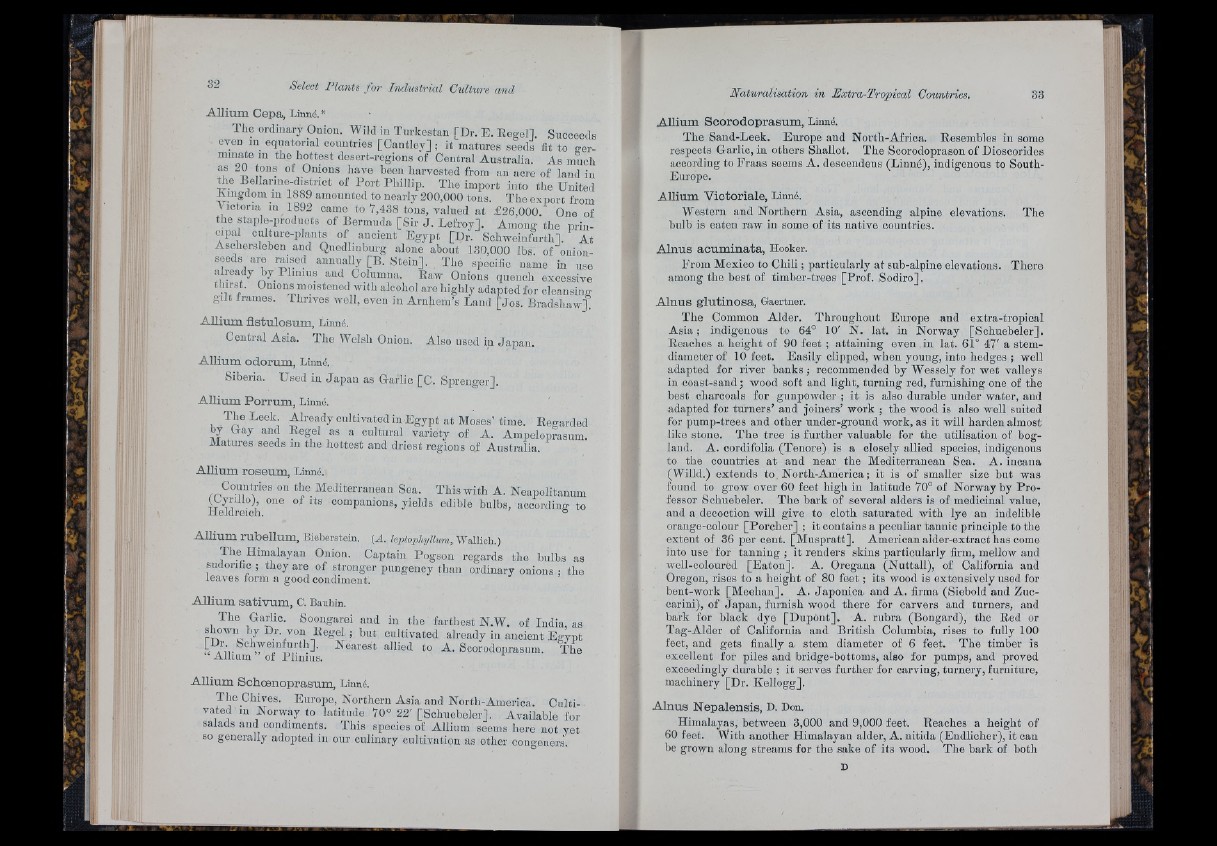
A llium Oepa, Linné. *
The ordinary Onion. Wild in Turkestan [Dr. E. Kegell. Succeeds
even in equatorial countries [C an tlev ]; it matures seeds lit to germinate
m the hottest desert-regions of Central Australia. As mucli
as 20 tons of Omons have been harvested from an acre of land in
the Bellarino-district of Po rt Phillip. The import into the United
Emgdom in 1889 amounted to nearly 200,000 tons. The export from
\ ictoria in 1892 came to 7,438 tons, valued at £26,000. One of
the stiiplo-products of Bermuda [S ir J . Lefroy]. Among the iirin-
cipal culture-plants of ancient Egypt [Dr. Schweiiifurthl At
Asciierslebon and Quedlinbnrg alone about 130,000 lbs. of onion-
soeds are raised aimiially [B. Stein]. The specific name in use
already by 1 limus and Columua. Kaw Onions queucli excessive
thirst. Omons moistened with alcohol are highly adapted for cleansiuo-
gilt frames, thrives well, even in Arnhem’s Land [Jos. Bradsluiwj!
A llium fls tu lo sum , Linné.
Central Asia. The Welsh Onion. Also used in Japan.
A llium o d o rum , Linné.
Siberia. Used in Japan as Garlic [C. Spronger].
A llium P o r rum , Linné.
TheLeok. Already cultivated in Egypt at Moses’ time. Regarded
by Gay and Regel as a cultural variety of A. Ampeloprasum.
Matures seeds in the hottest aud driest regions of Australia.
A llium ro s e um , Linné.
Mediterranean Sea. This with A. Neapolit.anum
IMdreteh ° companions, yields edible bulbs, according to
A llium ru b e llum , Bieberstein. (A. leptophyllum, Wallicli.)
The Himalayan Onion. Captain Pogson regards the bulbs as
sudorific ; they are oi stronger pungency tliiui ordinary onions : the
leaves form a good coiidiment.
A llium s a tiv um , C. Bauhin.
The Gariic. Soongarei aud in the farthest N.W. of India, as
shown by Dr. von Regel ; but cultivated already in ancient Egypt
L A ir Allu im of Plinius. Scorodoprasnin. The
A llium S c hoe n o p ra sum , Linné.
The Chives. Europe, Northern Asia and Nortli-Anierica. Cultivated
in Norway to latitude 70° 22' [Sclmebeler]. Available for
salads and condiments. This species of Allium seems hero not yet
so generally adopted in our culinary cultivation as other congeiiors'.
A llium S c o ro d o p ra sum , Linné.
The Saiid-Leek. Europe and North-Africa. Resembles in some
respects Garlic, in others Shallot. The Scorodoprason of Dioscorides
according to Fraas seems A. descendens (Linné), indigenous to South-
Europe.
A llium V io to ria le , Linné.
Western and Northern Asia, ascending alpine elevations. The
bulb is eaten raw in some of its native countries.
A ln u s a c um in a ta , Hooker.
Prom Mexico to Chili ; particularly a t snb-alpine elevations. There
among the best of timber-trees [Prof. Sodiro].
A ln u s g lu tin o s a , Gaertner.
The Common Alder. Throughout Europe and extra-tropical
Asia ; indigenous to 64° 10' N. lat. in Norway [Schuebeler].
Reaches a height of 90 feet ; attaining even in lat. 61° 47' a stem-
diameter of 10 feet. Easily clipped, when young, into hedges ; well
adapted for river banks ; recommended by Wessely for wet valleys
in coast-sand ; wood soft and light, turning red, furnishing one of the
best charcoals for gunpowder ; it is also durable under water, and
adapted for turners’ and joiners’ work ; the wood is also well suited
for pump-trees and other under-ground work, as it will harden almost
like stone. The tree is further valuable for the utilisation of bog-
laiid. A. cordifolia (Tenore) is a closely allied species, indigenous
to the countries a t and near the Mediterranean Sea. A. iiicana
(Willd.) extends to. North-America ; it is of smaller size but was
found to grow over 60 feet high in latitude 70° of Norway by Pro fessor
Schuebeler. The bark of several alders is of medicinal value,
aud a decoction will give to cloth saturated with lye an indelible
orange-colour [Porcher] ; it contains a peculiar tannic principle to the
extent of 36 per cent. [Muspratt]. American alder-extract has come
into use for tanning ; it renders skins particularly firm, mellow and
. well-coloured [Eaton]. A. Oregana (Nuttall), of California aud
Oregon, rises to a height of 80 feet ; its wood is extensively used for
bent-work [Meehan]. A. Japónica and A. firma (Siebold and Zuc-
carini), of Japan, furnish wood there for carvers and turners, aud
bark for black dye [Dupont]. A. rubra (Boiigard), the Red or
Tag-Alder of California aud British Columbia, rises to fully 100
feet, aud gets finally a stem diameter of 6 feet. The timber is
excellent for piles and hridge-bottoms, also for pumps, and proved
exceedingly durable ; it serves further for carving, turnery, furniture,
machinery [Dr. Kellogg].
A ln u s N ep a le n s is , D. Don.
Himalayas, between 3,000 and 9,000 feet. Reaches a height of
60 feet. With another Himalayan alder, A. nitida (Eudlicher), it can
be grown along streams for the sake of its wood. The bark of both
D